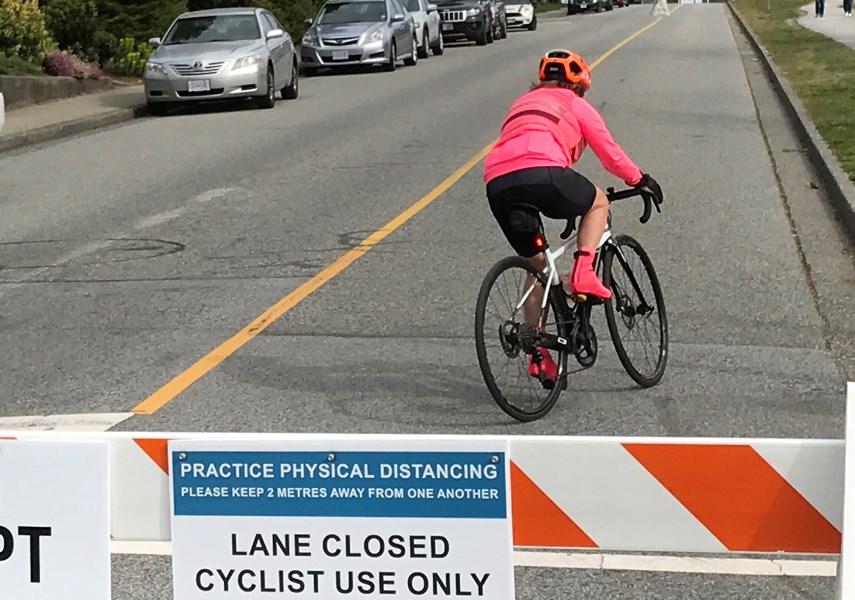There are some interesting knock-on effects of the pandemic.
As car traffic evaporates, it is easier to see just how gigantic our streets are. Their emphasis on vehicles leaves very little room for anything else, like walking or biking.
Now all this pavement is just lying there empty. At the same time, people on skinny sidewalks and packed greenways are sometimes forced to ignore the prudent two-metre distancing rule. In response, cities are starting to close vehicle and parking lanes – seeking spaces big enough for people to safely maintain physical distance. Municipalities are getting creative. Including ours here on the North Shore.
Last Friday, the City of North Vancouver reallocated the northbound vehicle lane on West Grand Boulevard from Keith Road to 19th Street to bikes. Now, people driving cars can only travel one way down this street. The other lane is open to people riding bikes in both directions. The change is intended to provide more space for pedestrians in the park by moving people cycling off the bike lanes over to the street. The virus dictates physical distancing, which requires more space. This plan makes sense.
More public spaces may be twinned if the need to maintain physical distance continues, the weather improves and people go stir-crazy from watching the entire Star Trek pantheon from the 1960s on. The Spirit Trail in high-density areas like Lower Lonsdale will likely see the separation of people walking from people on bikes. Across the water, Vancouver shut down Stanley Park to vehicle traffic, turning its roadway and part of Beach Avenue over to bikes. This was to accommodate social distancing on the seawall and to stop people from afar visiting the park.
All these roadway reassignments don’t have a lot to do with promoting walking and cycling as a form of transportation. Most of the reassignments we have seen so far are intended to increase space for people exercising in the outdoors, not to enhance active transportation networks. Though sometimes the two can overlap.
But the roads are quiet. All that pavement is calling. Now might be the perfect time for municipalities to provide more room for people who do walk or use a bike for essential transportation – especially for those who opt-in now because they don’t want to risk taking the bus and don’t own a car. Here are some ideas where temporary “flow” lanes – delineated by pop-up traffic cones and signs – might work to develop an active transportation network and enable distancing.
Reallocating a lane of parking on Lonsdale from 13th up to 23rd would provide more space for people walking and cycling. People in this neighbourhood often shop on foot and by wheel already. Let’s make it safer.
Esplanade’s sidewalks are wide, but this is a densely populated area. The now-empty roadway could easily give up a vehicle and/or parking lane for people walking and cycling, making this notorious corridor safer for cyclists and more distancing-friendly for pedestrians.
The low-level route between Welch and 3rd Street, along 1st and 2nd, is very broad and could easily support bike lanes on both sides. A temporary bike-only flow lane here would twin the Spirit Trail which could be made pedestrian-only.
Lynn Valley Road, the entire way up from Highway 1 to Lynn Headwaters, could support a flow lane. This lane should be designed for both people cycling and people walking because, for the most part, the sidewalks on Lynn Valley Road are too narrow to permit physical distancing.
Will extemporaneous re-engineering of our streets during a global pandemic have long term positive impacts on active transportation? I hope so. Enabling more people to walk and cycle safely for essential travel could have a long-term positive consequence: more people walking and cycling. Behaviours can change! For the new flow lane alongside Grand Boulevard, the answer is maybe. This route is also on the list for active transportation because it connects Lynn Valley to Central Lonsdale. The possibility here is that residents along the park might appreciate the new bike lane and not kibosh it the next time it is up for permanent installation. I hope so.
Heather Drugge is a sustainable transportation advocate who has used her bike for transportation for 20 years. She’s looking at getting an e-bike and maybe a jetpack next. [email protected]



